As cars go faster, air openings feed engines with an ever decreasing amount of air. Watching Bobby Allison slide his Penske Matador through the turns on a half mile or at Daytona was cool – the engine had plenty of air for cooling and the Matador nose could double as a snow plow during a heavy Michigan winter. In those days, the front opening on the car was so big you could use a racecar grill for a BBQ cook top that would hold enough steaks to feed the entire Allison clan.
Adjustable Radiator Mounting Brackets
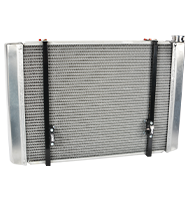 Adjustable radiator mounting brackets allow for quick experimentation. The roll bar clamp on brackets lets teams adjust the mounting angle quickly. Down force and radiator surface area can be optimized in seconds. Over time, teams can identify the optimal mounting position utilizing hardware that is designed to promote easy adjustment.
Adjustable radiator mounting brackets allow for quick experimentation. The roll bar clamp on brackets lets teams adjust the mounting angle quickly. Down force and radiator surface area can be optimized in seconds. Over time, teams can identify the optimal mounting position utilizing hardware that is designed to promote easy adjustment.
Going back in time, stock cars were built to bump, grind and to slide around – aero down force was reserved for Formula 1 and Indy. Dents in the fenders had little effect on speed. Today, an 1/8” variation on a stock car front fender width can take the car from loose to an aero push with the slightest of bumps. Grill of today perform only one hot dog at a time.
A Penske Matador, with an Allison at the wheel, could actually use muscle to power on to victory lane. Cars that rely down force are required to baby their way around the track and the grill opening feeds a finely metered amount of air to the radiator. While old school was more fun, it seems we are stuck with finding more aero advantage and driver muscle is reserved for Sharpie’s and autograph lines.
Since it seems unlikely that stock car grills will be coming out of ’55 Chevy’s anytime soon, teams face the challenge of keeping the engine at optimal operating temperature while maintaining an anorexic grill opening. The optimal grill shape – thin with nothing other than well placed tape directs air precisely. You would think stock cars were getting ready for the Red Carpet and Hollywood Paparazzi verses lining up for the starting grid.
When it comes to the coolant system, proper radiator mounting is an area where cooling can be maximized and speed can be gained. From experience, with plenty of room for debate depending on the car type and track, 7 degrees of forward mounting angle at the top of the radiator increases the radiator surface area while producing additional front down force. Air ducting from the grill opening needs to be tightly sealed and shaped properly to provide maximum cool air while traveling through a minimum space.
Radiator duct panels should be wide and flat (nearly parallel to the ground) at the bottom. Extending the bottom panel of the radiator duct work out at the nose piece is a “semi-legal cheat” that helps seal the nose area of the car with a “belly pan” that is disguised as radiator duct work.
Often, teams build the grill duct work the same width as the radiator. By extending the width of the bottom panel at the front of the car, you can gain some down force by using the bottom sheet metal radiator duct panel, at the nose piece, wider than the radiator. The duct work sides can still seal at the grill opening extending back to the radiator. Proper radiator duct shape enhances air movement for efficient cooling. “Stretching” the bottom panel outside of the grill width gains you a few inches of belly pan and it is likely that it won’t be noticed by the competition and often gets through tech without issue.
At the nose, the top panel of the radiator duct work should start nearly parallel to the ground with a few degrees of upward angle for the first 6” or so to reduce lift. The top panel transition, after the first 6” or so, should smoothly round up to the top of the radiator producing maximum cooling while producing extra down force. Working the ducting shape in your favor can provide for better down force numbers while improving cooling efficiency.
Since reliance on aero for handling is here to stay, then teams must find ways to manage consistent and controllable engine temperatures while striving for the minimum front end air opening. A variety of options are available to keep things cool in the heat of battle. Like all things in racing, finding many small areas of advantage works much better than hoping for a fix that comes from a single magic source.
IR pyrometers can help teams to identify hot spots providing an opportunity to direct air through duct work to critical areas in the cooling system. Isolating potential hot spots with an IR pyrometer can display areas where more air flow or improved radiator duct shapes will help to drop water temperatures.
Infrared Pyrometer
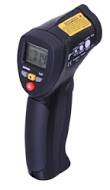 An Infrared Pyrometer can be utilized to instantly measure cooling system adjustments. As teams experiment with their coolant system efforts, the IR pyrometer can be used to spot check multiple system locations with precision. Improvements can be recorded and experiments that have a detrimental effect can be quickly rectified by taking multiple measurements with an IR pyrometer.
An Infrared Pyrometer can be utilized to instantly measure cooling system adjustments. As teams experiment with their coolant system efforts, the IR pyrometer can be used to spot check multiple system locations with precision. Improvements can be recorded and experiments that have a detrimental effect can be quickly rectified by taking multiple measurements with an IR pyrometer.
When experimenting with radiator ducting shapes an IR pyrometer can help you determine if you are making gains. Assuming you are at the same track, with the same outside ambient temperature, you can take an IR reading on piece of sheet metal that is temporarily mounted behind the radiator and in front of the engine. The is plenty of room for error with this method but, if you can repeat the number of laps, time it takes to get to the car, outside air temps and as many variables as possible then you can find improvements over time by taking an IR reading on your test sheet metal and compare temperature changes based on the changes you make.
Examples of cut and try items for improved cooling are radiator mounting angle, radiator duct shapes, grill tape and more. Since short track racers have limited engineering and testing time of Cup teams, it may take weeks to learn which experiments are producing positive results. Still, gains can be found if you are willing to cut and try and spend more time than your competition.
Freeze Plug
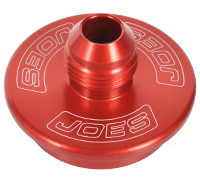 Freeze plug adaptors allow racers to tap the water system, changing flow as needed. With the right hardware water flow can be managed to meet any requirement.
Freeze plug adaptors allow racers to tap the water system, changing flow as needed. With the right hardware water flow can be managed to meet any requirement.
Quality water temperature gauges will provide you great information relating to the average temperature of your coolant. If the IR pyrometer helps you to identify a hot spot in the engine compartment then directing air precisely can help to lower the overall under hood temperature created by outside forces. Saving money on a water temp gauge may seem like a good idea but to produce long lasting horsepower your team must work with your engine builder to identify operating temperatures that produce maximum horsepower. Accuracy is needed to monitor temps to create the ultimate horsepower available.
Locating your water temp gauge probe in the ideal position can help your team to find the “ideal” measuring location. Temperature Tee’s can be installed in line in selected water hoses helping you to measure how your innovative ideas relating to water temperature are performing. For testing purposes, more than one water temp gauge can be installed and your team can use multiple Temp Tee fittings in line on various hoses. Multiple water temp gauges can be used for testing so your team can get take measurements of the water system at critical locations. By checking your water temps in strategic locations, your team can visually see how water treatment ideas are working out.
Temperature Tee's
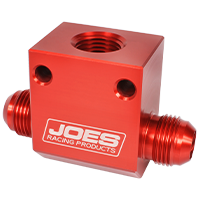 Temperature Tee’s come in a variety of line sizes and allow water temp gauge probes to be located in nearly any location in the cooling system. Successful teams experiment by connecting multiple Temperature Tee’;s in several locations. Using multiple water temp gauges at key system locations can help you to sort out coolant system issues.
Temperature Tee’s come in a variety of line sizes and allow water temp gauge probes to be located in nearly any location in the cooling system. Successful teams experiment by connecting multiple Temperature Tee’;s in several locations. Using multiple water temp gauges at key system locations can help you to sort out coolant system issues.
Some engine builders route engine water to manage temperatures at precise locations. Freeze plug adapters provide easy access to tap into the water system and hoses can be easily installed to route water as needed.
Coolant additives can help the longevity of your cooling system components. Anti corrosives and lubricating properties can be a big benefit and even save money over the long haul. Water cooling claims made by additive manufactures should be considered by each customer and their specific needs – a well designed system is needed and simply pouring in an additive will do little to fix a system that is designed poorly.
Ported Water Outlet fittings, at the intake manifold, are another area where the coolant system can be easily tapped to improve water flow. Adding a Thermo Spacer provides a clean mounting location for water temp senders right at the engine intake – temps taken as water enters your engine provide a great way to verify if your water cooling efforts are headed in the right direction. The additional ports, in Ported Water Outlet Fittings, allow racers to direct water flow to meet nearly any requirement.
Ported Water Outlet
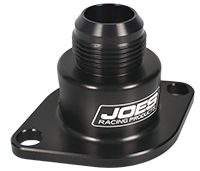 Ported Water Outlet fittings can be located right at the intake manifold and are a reliable place to monitor cooling system improvements. Extra ports allow for a quick tap of the water system to directing needed coolant in a simple fashion. An O-ring seal ensures that your system stays water tight.
Ported Water Outlet fittings can be located right at the intake manifold and are a reliable place to monitor cooling system improvements. Extra ports allow for a quick tap of the water system to directing needed coolant in a simple fashion. An O-ring seal ensures that your system stays water tight.
On cool nights, more grill tape may be needed to get your engine up to operating temp. Heat is horsepower and I can think of many early spring nights where the grill opening was nearly sealed off completely. The added front down force made the car faster as long the corresponding amount of rear down force was added. Down force nearly always wins out over aero drag on short tracks.
Water Expansion Tank with a Billet Cap Flange
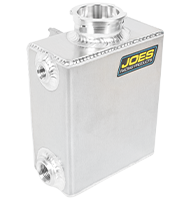 A water expansion tank with a Billet Cap Flange has the muscle to perform. Utilizing high pressure lines and quality water coolant components allows teams to run maximum cap pressures. A Billet cap connections ensures a perfect seal as compared to stamped aluminum cap flanges that can fail under pressure.
A water expansion tank with a Billet Cap Flange has the muscle to perform. Utilizing high pressure lines and quality water coolant components allows teams to run maximum cap pressures. A Billet cap connections ensures a perfect seal as compared to stamped aluminum cap flanges that can fail under pressure.
Optimizing horsepower, by keeping the water temperature in heat range that creates the most horsepower, is managed on a race by race basis. Tape, jetting, fans and the like are tailored based on the conditions that vary each week – sometimes each hour.
Thermo Spacer
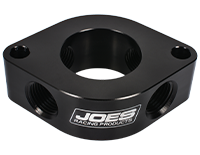 A Thermo Spacer, used at the intake manifold, provides easy access to the water system. Creativity can be maximized while maintaining a clean and professional installation. O-Rings keep the water in your engine so your team can focus on making more power.
A Thermo Spacer, used at the intake manifold, provides easy access to the water system. Creativity can be maximized while maintaining a clean and professional installation. O-Rings keep the water in your engine so your team can focus on making more power.
Competition gets tougher every week and teams that strive to find the smallest gains win more often. I deal with Cup teams that have custom parts made that save only 1 gram of weight. As short track racers, we often think of saving pounds at a time. Cup teams use the finest resolution possible and think in terms of saving a single gram. Over time, the single grams saved pile up and the result is a car that is as light as possible. The same philosophy applies to the cooling system. The teams that strive to explore cooling system improvements will beat the heat and their teams will run consistently hot.
